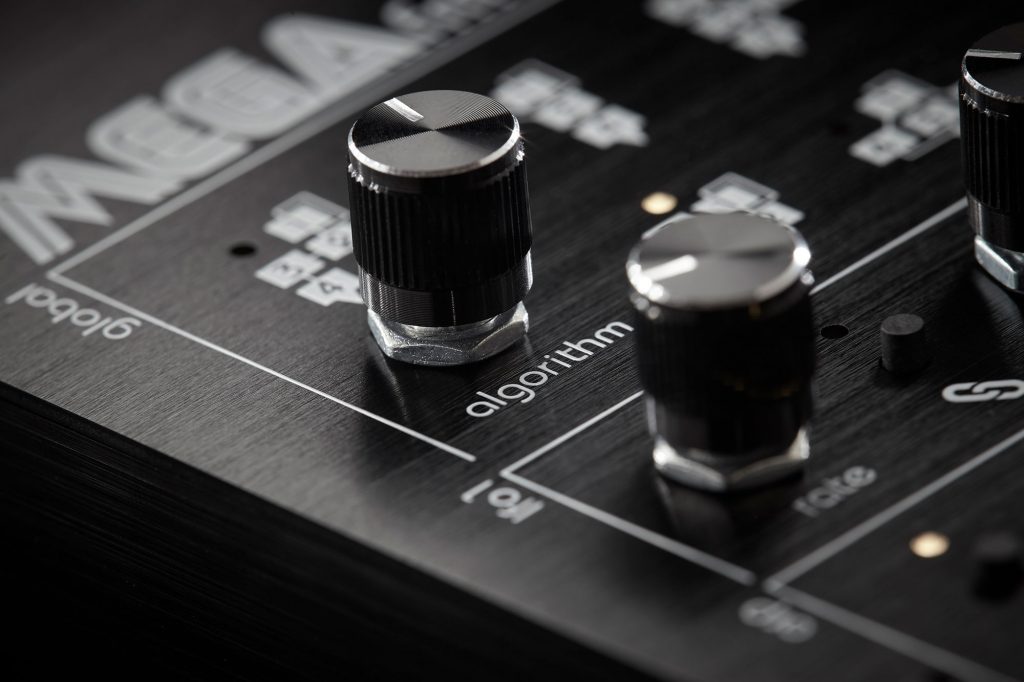Packing a unique digital sound engine based on 80s Sega games console chips, the MegaFM is full of character. Greg Scarth puts it to the test.

The Twisted Electrons MegaFM is a synth which sounds interesting before you even plug it in. The concept itself is intriguing: a 12-voice frequency modulation synth based on the chips found in late 80s games consoles, specifically in this case the Sega Mega Drive/Genesis. The update for the MkII model is about as simple as it gets, consisting of little more than a change from the Yamaha YM2612 chips used in the MkI model to the functionally identical YM3438. Sound chips aside, the MkII model looks and works identically to the original version, but given that this is our first review of either generation we’ll start at the beginning.
FM synthesis is a digital synthesis approach which is undeniably powerful but widely considered more tricky to program than analogue or virtual analogue approaches. The most commonly known implementations of FM are found in Yamaha DX series synths including the iconic DX7 and DX100 plus the current Reface DX model. Modern FM synths such as Korg’s Opsix and Volca FM offer a slightly more simplified approach to programming. With that said, the approach of the MegaFM is one of the most intuitive approaches to FM synthesis you’ll come across. The entire synth engine is essentially boiled down to a few very clear building blocks. At the top left of the unit you’ll find the algorithm section, which controls the routing of the four operators (the digital sine wave oscillators which are used to modulate each other in FM synthesis). Each operator is controlled by an identical bank of eight sliders, controlling detune, multiplier (the ratios of the operator frequencies to each other), total level, plus amp envelope settings. There’s no master envelope to control the shape of the sound, so this is handled on an operator-by-operator basis, with the controls being ar, dr, sl, sr and rr for each operator (attack rate, decay rate, sustain level, sustain rate and release rate).
Beyond this basic setup, there’s really not that much more to the MegaFM’s controls. There’s an arpeggiator and preset storage, but in terms of the sound itself your only other options are some voicing settings, a dedicated vibrato section and the LFOs to add modulation. Don’t make the mistake of thinking that’s a bad thing; the potential complexity of programming FM synths has always been their main drawback, as anyone who’s ever tried to program an original Yamaha DX will confirm. Instead, the MegaFM’s easy, one-knob-per-function design makes it quick and intuitive to program sounds.

The first thing to note about the MegaFM’s sound is that it’s probably not what you’d assume a video game synth would sound like. We’re not talking about lo-fi 8-bit chiptune bleeps and bloops here – not that there’s anything wrong with that in the right context – but instead a more classy, high-end take on video game sound. You can do that kind of glossy-but-dirty Sega soundtrack stuff with ease, but the depth and versatility of the MegaFM is hugely impressive. Dial in the unison setting and it’ll do the fattest of techstep/neurofunk bass sounds. Switch to Wide6 mode and you can summon up ethereal stereo pads. Explore the arp section, hook up a reverb and you’ll soon be in IDM territory. There’s certainly a bit of a 90s vibe here, but the sound is timeless, just as keen to be coaxed into pure, delicate sounds as well as gritty, distorted and atonal timbres.

Above all else, the MegaFM proves to be incredibly good fun. It’s an extremely hands-on instrument, encouraging you to experiment with settings and see what happens (something which you could never accuse classic FM synths like the DX7 of doing). Switching through the algorithms can change the sound quite dramatically, with the manual suggesting that each algorithm is best used for specific types of sound such as harps, strings, brass and pianos. In practice, the MegaFM quickly works its way out of imitating acoustic instruments and finds itself in much more experimental territory. There’s huge fun to be had by assigning an LFO to the algorithm control (the three LFOs are assigned to parameters simply by pressing a small ‘link’ button between each of the respective rate and depth controls). The depth knob then becomes a real-time control allowing you to warp the algorithm as a sequence plays, twisting and turning the sound while retaining similar characteristics for the operators. Quick, easy and indicative of the kind of unique, experimental approaches the synth excels at.

The MegaFM is that rare thing, a synth with its own unique character. At just under £500, it’s slightly pricey compared to more mainstream offerings like the Korg Opsix, but you get something a bit more distinctive. Boutique synths like this don’t always appeal to everyone – the MegaFM is a MIDI module with no keyboard (although it’s worth noting that the MIDI implementation is excellent, with full CC control of just about every parameter and a free software editor available to download) – but if you’re in the market for unique, distinctive sounds it’s a surefire hit.
Greg Scarth
More info/buy